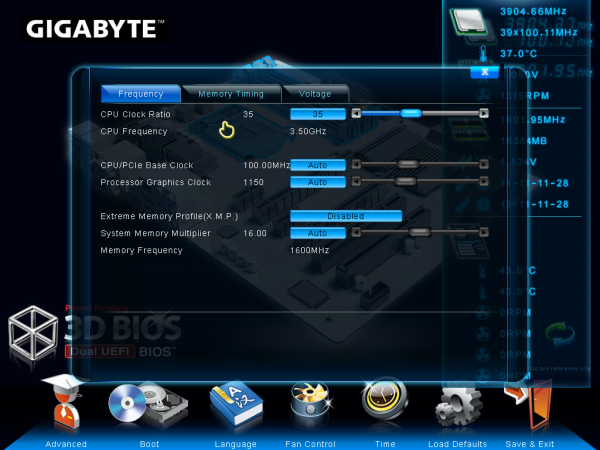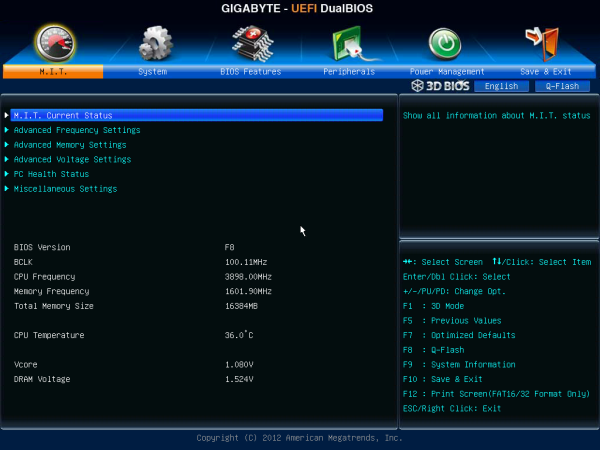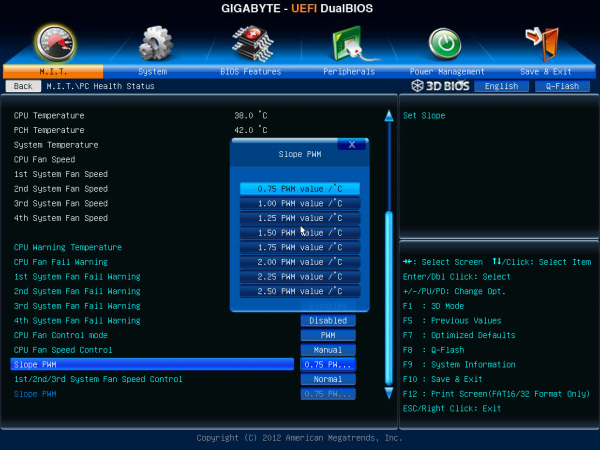Gigabyte GA-Z77X-UD5H Review: Functionality meets Competitive Pricing
by Ian Cutress on July 25, 2012 5:00 AM EST- Posted in
- Motherboards
- Gigabyte
- Z77
Gigabyte GA-Z77X-UD5H BIOS
As of late, I have been critical of the Gigabyte BIOS system. Their 3D BIOS implementation of a graphical UEFI used to be very slow to respond, and as a result made it a pig to navigate. Fast forward on a generation and our 3D BIOS is super fast, highly responsive, and more of a pleasure to use. The 3D BIOS philosophy is a little odd, as the only thing 3D about the BIOS screen is the perspective - it is still a 2D image but at an oblique angle.
The front screen of the Gigabyte BIOS uses this oblique image to act as a clickable interface for different parts of the motherboard. Users can select the CPU, the memory, the rear IO, the PCIe, the SATA connectors or the chipset in order to bring up a separate menu containing several advanced options for that area of the motherboard. This unfortunately falls down on a few areas:
Should a non-enthusiast user have this system as part of a pre-built computer (for example, my parents) and need to enter the BIOS, they will not know what to click as they do not understand what a motherboard is. I would not be able to explain 'click the SATA ports' as they do not know what SATA ports are. What we could do with here is some hover text over each part to explain what each part is in non-technical language.
In addition, as an enthusiast, my main priority of a BIOS is to manipulate and diagnose. The first screen I should see should have all the important information on it - the motherboard I am using, the CPU installed, the speed of the CPU (voltages and temperatures would be handy), the memory size, the memory speed, and other relevant data (boot sequence, hard drives). With a screen like 3D BIOS, some of this information is available straight away, and some is provided when the oblique image is clicked (see image below) but is covered by the menu brought up. For the real information, I will need to navigate through separate menus. There is enough leeway with a UEFI to be able to cater to both the enthusiast and the non-technical; it is just a shame that motherboard manufacturers still cannot get it right.
In the advanced menu, the first screen we come to is the M.I.T (Motherboard Intelligent Tweaker?). This has some valid information to greet us - BIOS version, CPU speed and voltage, memory size, frequency and voltage, and CPU temperature. The 'Current Status' option provides a longer list of exact settings, helpful for diagnosis.
Overclock options are found throughout several menus: CPU clocks and ratios are adjusted in "Advanced Frequency Settings"; memory timings and straps can be changed in "Advanced Memory Settings"; and anything relating to voltages or the 3D Power delivery options are found in "Voltage Settings". It does confuse me a little, as motherboard manufacturers have this overwhelming tendency to put options in one place only. The BIOS should be a tool that is easy to use, so why not put the voltage options for the CPU in with the CPU clocks and ratios? Or 3D Power options related to a CPU in a sub-menu in the Frequency options? The only motherboard manufacturer who is not using what is essentially a basic text and option interface right now is Intel on their own motherboards, so it does strike me as strange that no-one else is doing it.
Fan options in the BIOS are found in the M.I.T. -> PC Health Status menu, located at the bottom. Gigabyte fan controls are limited at best, especially when you compare them to the best in the motherboard arena - users here have to try to understand the options provided. The units PWM value / ºC mean nothing to everyone. Some sort of system needs to be devised here which users can input temperatures when they want the fans to idle and when they want the fans to be at 100%, and the BIOS calculates the appropriate 'PWM value/ºC' to select.
Despite my critical analysis of the Gigabyte BIOS, I found it easy to navigate by the arrow keys (my preferred method) and type in values during overclocking. It is a big step up from the first iterations of Gigabyte's 3D BIOS for sure.




















70 Comments
View All Comments
Dustin Sklavos - Wednesday, July 25, 2012 - link
Derp. Well, color me stupid.Nice one, though. ;)
Belard - Thursday, July 26, 2012 - link
Okay, you are stupid.Well, for another reason. Nobody makes a keyboard worthwhile to replace the one I use today... 1996 era. This keyboard *IS SO OLD*, its not even a PS/2! Its an AT-connector, plugged into a PS/2 3" Adapter into an extended PS/2 cable. A USB convert doesn't work.
But gigabyte makes many boards with ps/2 ports.
VGA is not needed on a high end board (lower end $60~120 boards have VGA).
And actually, a floppy connector *IS NOT* needed of modern boards. When a modern board like Gigabyte doesn't include a floppy connector, they can update the BIOS from within the OS or with a flash drive.... far easier than a stupid old-school floppy drive (I keep one just in case).
DigitalFreak - Wednesday, July 25, 2012 - link
Did you test the VIA USB 3 chip performance, or only the Intel PCH controller?Mustang66 - Wednesday, July 25, 2012 - link
Are the two red USB ports on the back 2.0 or 3.0? The paragraph says they're 3.0 but the feature list seems to infer they are 2.0.IanCutress - Wednesday, July 25, 2012 - link
Sorry, the red ones are USB 2.0. USB 3.0 on every manufacturer is currently blue (for now).Ian
cameleon - Wednesday, July 25, 2012 - link
No Dual link DVI Port on HD4000, so I can't run my old 30" display without dedicated card.Craxit - Wednesday, July 25, 2012 - link
Display-Port to DVI-D cable?Same prob here.
PolarisOrbit - Wednesday, July 25, 2012 - link
So Gigabyte finally dropped VIA as the onboard audio provider on their motherboards. About time- I almost swore off Gigabyte because I had so much trouble with that driver!rickon66 - Wednesday, July 25, 2012 - link
I have this board and really like it. The board package includes a front panel USB 3 bracket so you can add USB3 to the front of your case. I thought that was a very nice addition. The board is built so stoutly that it could double as body armor.Craxit - Wednesday, July 25, 2012 - link
Has anybody found out how to switch on the boardby keyboard?
Can do wakeup from sleep using the kbd but not a cold start.